Analyzing the Chinese Market Environment
Critically analyse the macro and micro environment of the market environment in CHINA using appropriate analytical tools
Develop appropriate marketing objectives and critically analyse supporting corporate and business strategies to support the expansion of the IKEA brand in the CHINA
Critically analyse the potential Business Model of IKEA and its adaptation for the expansion of the brand in CHINA. In addition, justify
the most appropriate application of the marketing tactics that will support the expansion in CHINA
Task 1:Critical analysis of macro and micro environment of market in China through appropriate analytical tools-900
The SWOT (Strength, Weakness, Opportunities and Threats) analysis of IKEA efficiently highlights the micro environment of the company. Details from this analysis are efficient enough to identify the potential factors affecting the business of the company.
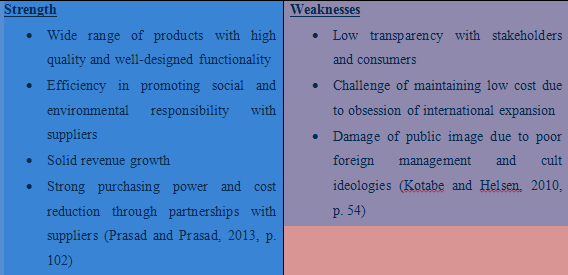
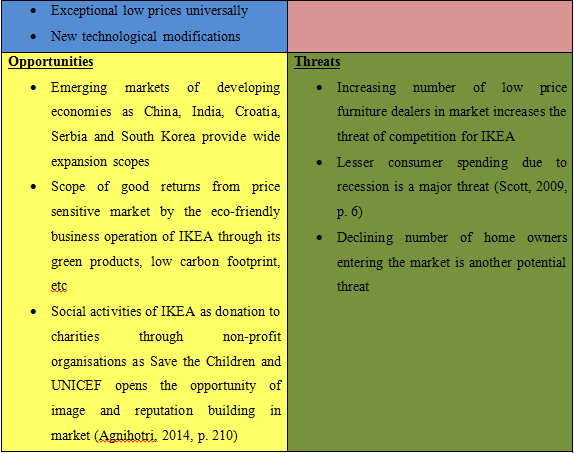
In order to analyse the macro environment the PESTLE (Political, Economic, Social, Technological, Legal and Environmental) analysis tool as opined by Li and Yang (2014, p. 4742), is an efficient one. It efficiently brings forth the eminent external factors affecting the business of IKEA in China.

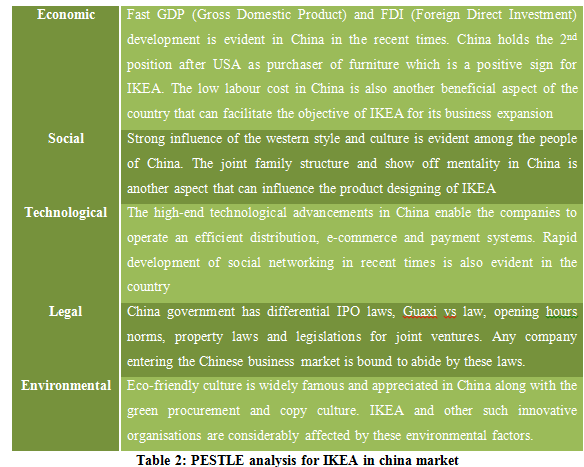
Porter’s Five Forces
The potent industrial factors affecting the company are efficiently highlighted by conducting the Porter’s Five Forces Analysis. As stated by (Porter-Steele, 2010, p. 79), the five major forces of this tool identify and give the details of significant factors that influence on the business conduction of a company in the concerned market. The Porter’s Five Forces analysis of furniture industry of China points out relevant information as follows:
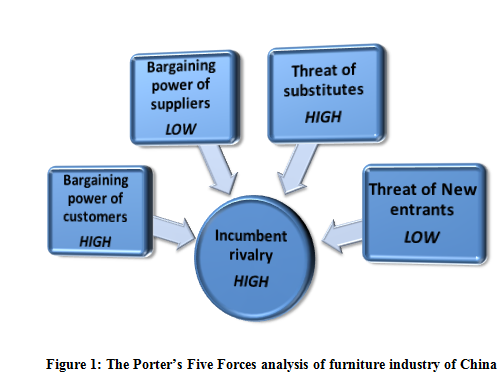
The high Bargaining power of customers indicates the availability of adequate number of furniture organisations in Chinese market (Shi and Smith, 2012, p. 82). The low bargaining power of suppliers on the other hand, identifies the high price sensitivity among the customers of China. This factor accounts for the consideration of the prices of IKEA products to be high in the Chinese market while the same price is considered low elsewhere. The need for large amount of capital investment is a major barrier to entry in Chinese market for most organisations. IKEA however, being a well-established company is expected to overcome this barrier easily. At the same time, it restricts the other smaller companies from entering the market thus, reducing the competition intensity to an extent. However, as asserted by (Agnihotri, 2014, p. 207), there are large numbers of furniture businesses operating in the Chinese market at domestic level. Therefore, IKEA is about to face tough competition from the domestic companies in Chinese furniture retail market.
The analysis highlights a failure of the retail giant Home Depot in Chinese market. There also exists a specific market culture. Thus it lowers the threat of new entrants into the furniture retail market of China. However, the tool pinpoints on the high Threat of substitutes in Chinese market. Existence of fake IKEA stores and ease of copying the products of IKEA by other retailers is an eminent threat lingering over IKEA in conducting its business efficiently in the Chinese furniture retail market. The high Incumbent rivalry evident in Chinese market is a major factor and threat for IKEA. The presence of strong players as B&Q and Taobao contributes to the increase in rivalry in the market of China. Jiang et al. (2013, p. 209) argued that there are several suppliers in China market who emerge as the direct competitors of IKEA.
Examining IKEA's Business Model for China
Task 2: Developing appropriate marketing objectives and critical analysis of business and corporate strategies supporting expansion of IKEA brand in China
IKEA can apply techniques and procedures as Hofstede Index, Psychic Distance Model, Perceptual map on positioning, marketing mix and segmentation to analyse market in China. It will direct the company towards the development of appropriate marketing objectives (Luther, 2011, p. 62).
Hofstede Index (Refer to Appendix 1)
It indicates that there exist a remarkable distinction in culture of China and Sweden, the home country of IKEA with a highlight on the “show-off mentality” among people of China. The preferred style and need of furniture differs widely among the 2 countries with China consisting larger families than in Sweden. On-line shopping emerges as a viable scope of business in China where mostly people are busy in work. As stated by Bessant (2009, p. 41), the index drives IKEA towards innovative products through depiction of wide acceptance of innovative items in China with the property of accepting changes very fast. However, a deeper focus is required for advertisement and customer attraction in China than in Sweden due to the lesser fun-loving culture of China.
Psychic Distance Model (Refer to Appendix 2)
This model identifies the marked language distance between the country of Sweden and China. It drives IKEA towards adoption of Chinese main language Mandarin for its business and marketing operations in China. IKEA can also set the store locations near offices as per the Chinese culture. A major focus on maintaining low price products by IKEA is essential in China due to the unstable economic conditions. The rule of paying 25% corporate tax in China raises the business expense of IKEA in China. However, the company is provided with ample investing opportunities by the Chinese government (Jiang et al. 2013, p. 205).
Perceptual map on positioning (Refer to Appendix 3)
As per the Perceptual maps of IKEA products in terms of quality and price in different countries, the company can efficiently position itself against its rivals in the respective countries of China, US, France, Germany, Austria and UK. The products of IKEA depict standard quality level in all the mentioned countries. Hence, IKEA stands at a better position than its rivals in terms of quality. However, China being a developing country shows the consideration of prices of IKEA products to be high. It leads to the development of conception that IKEA products in China market can be considered of good quality but highly priced.
Segmentation
IKEA can segment its target market as per the following criteria of Demography, Geography, Psychograph and Socio-graphic:
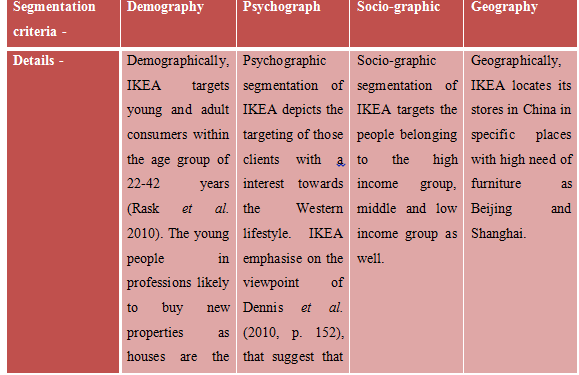
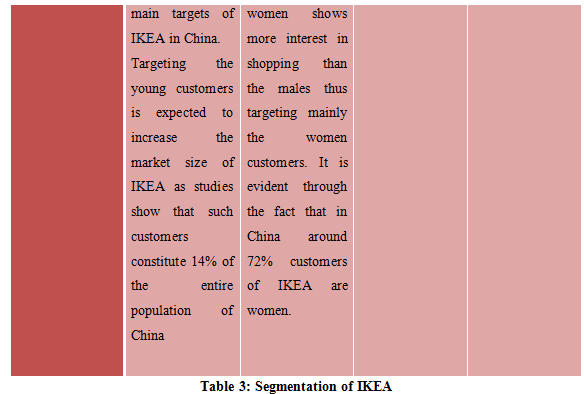

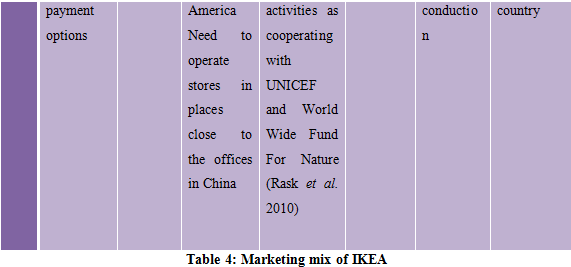
Corporate and business strategies of IKEA
As far as the corporate and business strategies of IKEA are concerned, its corporate strategy of offering low price products with functional and well-designed characteristics poses a challenge to the organisation in face of competition in market. It strategy of global outsourcing is effective in enabling it in cost reduction facilitating international expansion. Its corporate strategy is also effective in attaining low-cost labour and less expensive raw materials by providing scope of long-term high-volume business relationship with the country as is found in Vietnam (Høgevold, 2011, p. 395). Its business strategy of open communication facilitated knowledge sharing, streamlining decision-making, mastering new technologies in furniture production and effective advertising methods enabled IKEA to develop unique competitive advantage over other rivals in the industry.
Recommended Marketing Objectives and Tactics
Task 3:Critical analysis of potential business model of IKEA and its adaptation for brand expansion in China with most appropriate marketing tactics supporting the expansion
According to Hwang et al. (2013, p. 1506), business canvas model is a tool to create and analyse business models. Most of the company can create this model easily. But the main thing that every company has to make sure is that they must analyze it and update the existing model with due course of time. As per the given case study organization IKEA has also a business model of its own.
Customer Segments: The target customer of IKEA is basically the families. The age varies from 30 and 35 and about 70% of their customers are women.
Customer Relationship: According to Høgevold (2011, p. 384), IKEA does all the necessary activities to maintain a healthy relationship with the customer. This is the reason why they have reduced the price of their products as per the demand of customers.
Channels: IKEA mainly does its business through retail outlets. They provide very limited online service (Hellström and Nilsson, 2011, p. 640).
Value Propositions: IKEA successfully provides quality service within a less price. But in China the pricing strategy of their products are generally high.
Key Activities: In China market IKEA needs to expand more and they need to communicate with the customers through various social media sites.
Key Resources: IKEA has been very successful on this as they recruited more than 120,000 people around the world for their 315 stores. According to Michael Sayeau (2009, p. 494), last year was one of the most successful year for the company as they have been able to generate a revenue of 28.5 Billions of Euros.
Key Partners: IKEA being one of the top most furniture company brands has suppliers from almost different countries. 60% of their merchandise are sourced from Europe, Asia and North America (Hultman et al. 2012, p. 14).
Cost Structure: IKEA sources the merchandise from cost effective sources so sourcing is not that costly for the organisation but reducing the price in China has been very costly for the company.
Revenue Streams: As it is a furniture company so it’s main earning areas are from the hotel chains and restaurants. Their cheap rate and excellent product quality has made IKEA a popular household name in all over UK (Hellström and Nilsson, 2011, p. 640).
Criticism of their business model:
The main problem with their business model that sometimes their price leads them to loses. Although the pricing system is one of the major revenue generating components for the company, still they have to make some considerations while operating in countries like China where the pricing system is naturally high.
Another point of concern in their model is that, they are not concentrating much on the online media. They have a very limited service in this media, hence they may face some problem in the near future because the trend of online shopping has exploded so much that people hardly goes to a shop now. Online shopping is less time consuming and very effective for those people who don’t have time to visit shops personally.
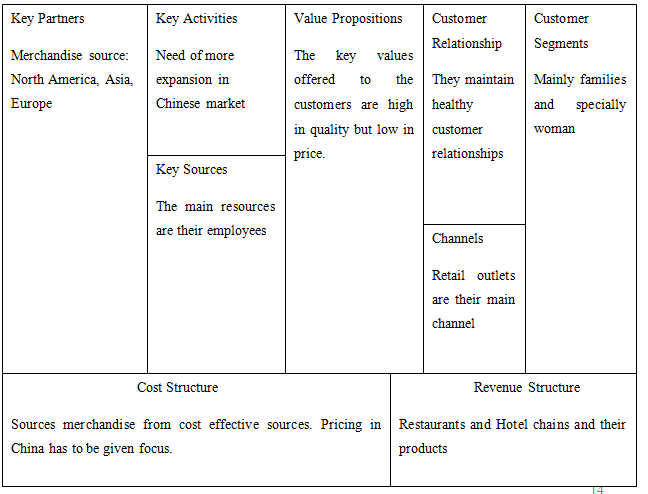
Figure 2: Business Model Canvas of IKEA
(Source: As created by the learner)
Conclusion:
This study highlights the essential aspects of global marketing in the context of IKEA organisation in Chinese furniture retail market. Although the company faced challenges regarding price reduction, differential government laws, culture difference, etc IKEA identifies methods to improve its market position. Taobao and B&Q the two main competitors of IKEA in Chinese furniture market can be well handled by the company through gaining adequate competitive advantage by adopting the measures as stated in the recommendations.
Recommendations:
In order to develop and attain an effective marketing operation and expansion in the Chinese market IKEA needs to focus on certain major factors. As per the issues highlighted in the study, the relevant recommendations are provided as follows:
Development of online-marketing techniques
IKEA with its sole focus on providing quality products at low prices, and market expansion overseas has neglected the adoption of technological features with time. The company lags behind in its online shopping provisions, which is highly advanced in most of the rival companies in Chinese market. The people in China with a busy schedule of work in their daily life show a high preference towards online-shopping. IKEA thus, needs to develop its online shopping infrastructure considerably to improve and enhance their efficiency of business in the Chinese market and attract more clients thus increasing sales and revenue. IKEA can also avail more customers and spread awareness of their products through improving their social networking activities which is quite popular in China.
Opening more stores in China
As highlighted in the business model section, IKEA has a smaller number of stores in Chinese market. In order to achieve an effective expansion, they need to set up more stores. Focusing on establishment of stores near the office area is a major recommendation for IKEA. As observed from the study, the Chinese people availing the stores mainly driven by need rather than luxury or fun. Therefore, setting the stores near the offices will attract more customers. Another recommendation for IKEA is to shift their focus from restaurants and hotels to offices. It is because in China, there are more offices and the focus is higher on office works than on hotels. Therefore, emphasising on offices, if IKEA designs their products as per the needs and expectations of office works, they can expect a better and more number of orders and purchase. Thus, the company needs to shift its focus as per the country needs.
Reference List
Books:
Bessant, J. (2009). Innovation. London: DK
Keegan, W. and Green, M. (2010). Global marketing. Harlow: Pearson Education
Kotabe, M. and Helsen, K. (2010). Global marketing management. Hoboken, NJ: Wiley
Luther, W. (2011). The marketing plan. New York: AMACOM
Journals:
Agnihotri, A. (2014). Mass-Media-based Corporate Reputation and Firms’ Market Valuation – Evidence from Emerging Markets. Corporate Reputation Review, 17(3), pp.206-218
Dennis, C., Morgan, A., Wright, L. and Jayawardhena, C. (2010). The influences of social e-shopping in enhancing young women's online shopping behaviour. J. Cust. Behav., 9(2), pp.151-174
Høgevold, N. (2011). A corporate effort towards a sustainable business model. European Business Review, 23(4), pp.392-400
Hellström, D. and Nilsson, F. (2011). Logisticsâ€ÂÂdriven packaging innovation: a case study at IKEA. International Journal of Retail & Distribution Management, 39(9), pp.638-657
Hultman, J., Johnsen, T., Johnsen, R. and Hertz, S. (2012). An interaction approach to global sourcing: A case study of IKEA. Journal of Purchasing and Supply Management, 18(1), pp.9-21
Hwang, J., Han, H. and Hwang, C. (2013). A Study on the application of Architectural Business Model Canvas of Urban Single Houses on the Viewpoints of Prosumers. The Journal of the Korea institute of electronic communication sciences, 8(10), pp.1505-1514
Jiang, N., Liping, W. and Sharma, K. (2013). Trends, Patters and Determinants of Foreign Direct Investment in China. Global Business Review, 14(2), pp.201-210
Johansson, U. and Thelander, Ã…. (2009). A standardised approach to the world? IKEA in China. International Journal of Quality and Service Sciences, 1(2), pp.199-219
Keller, H. and Thackeray, R. (2011). Social Marketing and the Creative Process: Staying True to Your Social Marketing Objectives. Health Promotion Practice, 12(5), pp.651-653
Li, L. and Yang, T. (2014). An Analysis of Furniture Manufacturing Industry Competitiveness Based on Design Innovation Investment. AMM, 687-691, pp.4741-4745
Lindqvist, U. (2009). The Cultural Archive of the IKEA Store. Space and Culture, 12(1), pp.43-62
Michael Sayeau, (2009). IKEA Modernism and the Perils of Innovation. Modernism/modernity, 16(3), pp.493-495
Mochon, D., Norton, M. and Ariely, D. (2012). Bolstering and restoring feelings of competence via the IKEA effect. International Journal of Research in Marketing, 29(4), pp.363-369
Porter-Steele, N. (2010). Book Review: Transactional Analysis: 100 Key Points and Techniques. Transactional Analysis Journal, 40(1), pp.79-80
Prasad, A. and Prasad, P. (2013). Innovation in the Global Age: Implications for Business and Management in the Knowledge Economy. IJBA, 4(6), pp. 102-106
Rask, M., Korsgaard, S. and Lauring, J. (2010). When international management meets diversity management: the case of IKEA. EJIM, 4(4), p.396. Scott, A. (2009). Notes from a recession. Business Strategy Review, 20(3), pp.4-10
Shi, W. and Smith, P. (2012). Exploring Market Opportunities for American Hardwoods through Chinese International Furniture Supply Trade Shows. Forest Products Journal, 62(2), pp.80-89
Websites:
China, C. (2015). Case analysis Ikea in China. [online] Academia.edu. Available at: https://www.academia.edu/6652225/Case_analysis_Ikea_in_China [Accessed 8 Jan. 2015].
Dudovskiy, J. (2014). IKEA Porter’s Five Forces Analysis - Research Methodology. [online] Research-methodology.net. Available at: https://research-methodology.net/ikea-porters-five-forces-analysis/ [Accessed 8 Jan. 2015].
Ikea.com, (2015). Facts & Figures - IKEA. [online] Available at: https://www.ikea.com/ms/en_GB/about_ikea/facts_and_figures/facts_figures.html [Accessed 8 Jan. 2015]
APPENDICES
Appendix 1
Hofstede Index (IKEA)
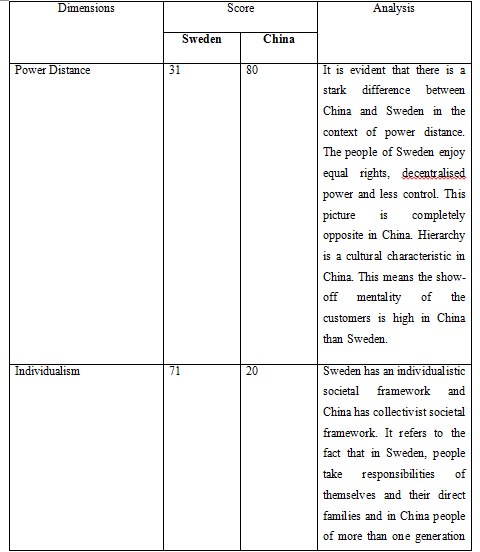

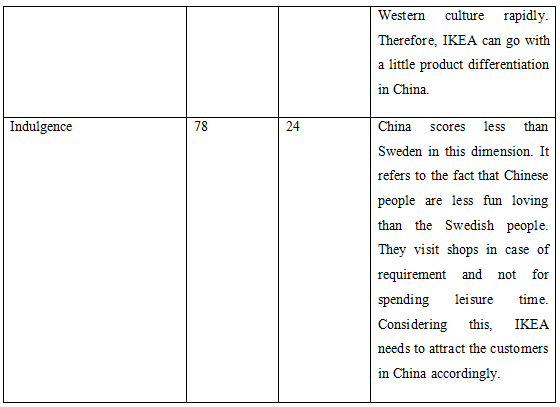
Psychic Distance Model

Appendix 3
Perceptual Map of IKEA products in Terms of Quality and Price in China

Perceptual Map of IKEA products in Terms of Quality and Price in France
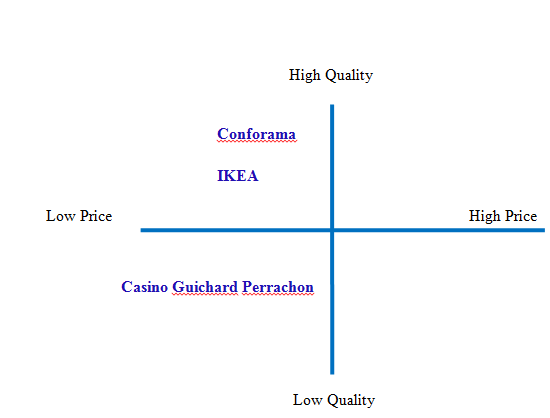
Perceptual Map of IKEA products in Terms of Quality and Price in USA
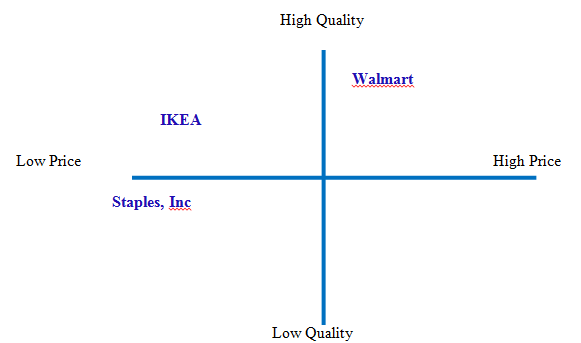
Perceptual Map of IKEA products in Terms of Quality and Price in Austria
To export a reference to this article please select a referencing stye below:
My Assignment Help. (2015). Critical Analysis Of Marketing Objectives, Business Strategies, And Potential Business Model For IKEA's Expansion In China (Essay).. Retrieved from https://myassignmenthelp.com/free-samples/global-marketing-management-ikea.
"Critical Analysis Of Marketing Objectives, Business Strategies, And Potential Business Model For IKEA's Expansion In China (Essay).." My Assignment Help, 2015, https://myassignmenthelp.com/free-samples/global-marketing-management-ikea.
My Assignment Help (2015) Critical Analysis Of Marketing Objectives, Business Strategies, And Potential Business Model For IKEA's Expansion In China (Essay). [Online]. Available from: https://myassignmenthelp.com/free-samples/global-marketing-management-ikea
[Accessed 22 May 2025].
My Assignment Help. 'Critical Analysis Of Marketing Objectives, Business Strategies, And Potential Business Model For IKEA's Expansion In China (Essay).' (My Assignment Help, 2015) <https://myassignmenthelp.com/free-samples/global-marketing-management-ikea> accessed 22 May 2025.
My Assignment Help. Critical Analysis Of Marketing Objectives, Business Strategies, And Potential Business Model For IKEA's Expansion In China (Essay). [Internet]. My Assignment Help. 2015 [cited 22 May 2025]. Available from: https://myassignmenthelp.com/free-samples/global-marketing-management-ikea.
